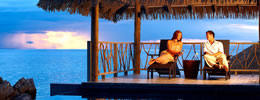Highlights
Santiago
Santiago is an incredibly beautiful
colonial city. Overlooking the city is the Virgin
Mary, sitting atop the Cerro San Cristobal at 860m.
While the city itself is quite large, many of the
tourist attractions can be found in its central core
which is small and quite manageable.
Mercado Central - This wrought-iron structure occupies
an entire block at 21 de Mayo and Avenida Balmaceda.
It’s easily Santiago’s most colourful
market and is home to many great seafood restaurants
Museo Chileno de Arte Precolombino - open from Tuesday
to Saturday, 10am to 6pm at Bandera 361, this museum
offers a thorough overview of 4500 years of pre-Columbian
civilization throughout Central and South America
Palacio de Bellas Artes - Located on Jose M de La
Barra near Avenida Jose Maria Caro, is Santiago’s
fine arts museum. It has permanent collections of
Chilean, Italian, French and Dutch paintings. Open
Tuesday to Saturday, 11am to 8pm, Sundays and holidays,
11am to 2pm
Palacio Cousino - This mansion was owned by one of
Santiago’s most prominent families of vintners.
It is open between 9:30am and 1:30pm daily, except
Mondays. To get there, follow Dieciocho 438 until
you reach Parque Alameda
Cerro Santa Lucia - Offers a respite from the bustle
of the downtown core. You can easily walk from downtown
to the east end of Huerfanos where you can catch an
elevator to the top Parque Metropolitano - Home to
Cerro San Cristobal - Take the teleferico, or aerial
cable car, to its summit at 485m for excellent views
of the city
Museo Nacional de Historia Natural – Located west of downtown, in the Parque Quinta Normal, this museum is very worthwhile. So are a number of other museums, all found in the same park. You can easily spend a half-day in this section of the city.
La Serena
Important both historically and
economically, the beachside city of La Serena is one
of Chile's oldest post-Columbian cities. The region's
silver, copper and agriculture were so important that
the city had its own mint. Today, La Serena maintains
a colonial air, although it is threatening Viña
del Mar's supremacy as the premier beach resort. Apart
from a string of beautiful beaches, attractions include
a handful of museums and a number of nearby quaint
villages and vineyards.
Parque Nacional Puyehue
Situated in the beautiful Lake District, this is Chile's
most popular national park. It preserves 107,000ha
(264,290ac) of verdant forest and awesome volcanic
scenery. Dense forest hides puma, the rare pudú
(a miniature deer) and prolific bird life, including
the Chilean torrent duck. Nature trails, lake views,
ski resorts, thermal springs, waterfalls and examples
of some of Chile's strange plant life, in particular
the umbrella-leaved nalca and multi-trunked ulmo,
are some of the many attractions which draw visitors.
Puerto Montt
Settled by German colonists in the mid-19th century,
this is one of southern Chile's most important cities.
It features middle-European architecture, with shingles,
high-pitched roofs and ornate balconies. The redwood
cathedral on the city's plaza is the city's oldest
building, dating from 1856. Puerto Montt is the transport
hub and access point to the southern Lakes District,
the island of Chiloé and Chilean Patagonia.
The nearby port of Angelmó and the island of
Tenglo offer a more relaxed atmosphere. Angelmó
has an outstanding crafts market and fabulous seafood.
Valparaíso
Lying 120km (74mi) northwest of Santiago, Valpo is Chile's principal port and second-largest city. Despite its size, it is Chile's most distinctive city and one of South America's most intriguing. Occupying a narrow strip of land between the waterfront and the nearby hills, its convoluted centre has distinctive, sinuous cobbled streets, and is overlooked by precipitous cliffs and hilltop suburbs which are accessed by funicular railways and stairway footpaths. It truly is a rabbit-warren of a place, which probably only a lifetime resident could completely fathom. It is conducive to maze-like strolls and rides on the funicular, and its natural history, fine arts and maritime museums are justly famed. Muelle Prat, the recently redeveloped pier, is a lively market area.
Chiloe
Only about 180km (112mi) long and 50km (31mi) wide, the Isla Grande de Chiloé is a well-watered, densely forested island of undulating hills, with a temperate maritime climate. It is linked to the Chilean mainland by ferries departing from the island's northern tip. Its towns feature distinctive shingled houses and stilt homes, and its weather is known for precipitation and fog. When visible, however, a majestic panorama across to the gulf to the snow-capped volcanoes of the mainland are revealed. Ancud and Castro are the only two sizeable towns, but there are over 150 picturesque wooden churches servicing the island's small villages. Parque Nacional Chiloé protects extensive stands of native coniferous and evergreen forest and a long and almost pristine coastline. The rare pudú also lives here.
Easter Island (Rapa Nui)
Lying 3700km (2294mi) west of the
Chilean mainland, enigmatic Easter Island is the world's
most remote inhabited island. It is actually more
Polynesian than Chilean, although the presence of
Pacific Islanders in this isolated part of the world
is as much a mystery as how their descendants managed
to design andsculpt the hundreds of colossal statues
(moai) from hard volcanic basalt - let alone transport
them from
the inland quarries to the coast. This really is off
the beaten track: you can sail more than 1900km (1178mi)
in any direction without sighting inhabited land.
Chile officially annexed the island in 1888 during
the period of expansion which followed the War of
the Pacific. Only about 2000 people live on the island,
and nearly all of them live in the town of Hanga Roa.
The population is 70% Polynesian, with most of the
remainder coming from the Chilean mainland. The island
is virtually an open-air national park, and boasts
300 moai and related stonework.
| >> |



